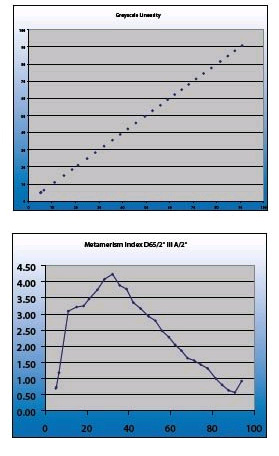articles/Printers/hpphotosmart-page3
HP Photosmart 9180 - part 3 of 1 2 3 4
by Mike McNamee Published 01/06/2008

Greyscale testing
Making neutral, well-graded monochrome prints is the ultimate test for an inkjet system. The HP 9180 can make mono prints using composite inks (ie all the inks) or using grey inks only. We tried both options using the same image onto the same piece of paper. We turned the colour management off in Photoshop for one set and then allowed 'Photoshop manages colours' for the other giving four prints in all. The resulting prints were different because of using composite inks or grey inks, but the colour management settings had no influence on the outcome. Use of all the greyscale settings created prints that were too dark, by 13% using all inks and by 22% using the grey inks only. These data are plotted alongside a greyscale image made using full colour inks and our own profile to act as a reference. The HP versions were not up to standard and some experiment would be needed before this route could produce exhibition-quality prints. There were only single point differences in the base colour of the 50% density greys. The grey ink only versions were a little cooler. The colour ink versions shifted towards cyan in north daylight, the grey ink only version remained neutral (see metamerism section below).
Metamerism
We noticed the metamerism quite early on in our testing, before we actually made any measurements. For the full colour (ie all colourants used) greys the metamerism peaked at 4.5 Lab ΔE when shifting from D65 light measurements to Tungsten Illuminant A. Things were better with the grey only inks when the metamerism was measured at 0.9ΔE Lab. The change of metamerism down the tone scale followed the hump shape found with Epson K3 ink, although the peak in the HP was very much higher (ie worse metamerism).
The effect of the metamerism was that greyscale images that were neutral in D50 or D65 light were green in natural north daylight and magenta in tungsten light.

Real prints
It is important to make real prints when reviewing printers; test targets sometimes give a false impression. We made a number of excellent prints. The very slight banding that we observed in solid blocks of 50% grey were not obvious in real prints with their mixtures of tones and details. It is also worth noting, before we leave the gloss material, that the higher metamerism in this paper has been replicated with some Epson semi gloss paper although not to the same degree. As we show later the metamerism was very much lower on other surfaces.
HP Hahnemuhle Smooth Fine Art Paper 265gsm
With sufficient weight to pass Fine Art Trade Guild standards, this is a 100% cotton rag, acid free offering that is classed as 'bright white'. There is no evidence of any OBA activity and so the brightness is assumed to be due to premium quality materials in the base.
With fine art media selected in the printer driver the 9180 chooses the matt black ink option seamlessly. The only care you need to take is to ensure that there is sufficient space behind the printer - it pushes the paper further back as it takes up an aligns the sheet.
We tested the paper using the profile provided with the driver CD and automatically installed with the printer. Unusually for a fine art matt media, the lightness error was the smallest. This was backed up with a good Dmax of 1.66, good tone separation down to 15RGB points and good highlight separation right up to 252 RGB points. The metamerism was measures at 1.0 Lab ΔE (D65 to Tungsten on 50% grey). The look of the print rather belied the rather poor statistics. The bulk of the error lay in the saturation component. Most viewers would deem the print to be commercially acceptable for portrait work.
Please Note:
There is more than one page for this Article.
You are currently on page 3
- HP Photosmart 9180 page 1
- HP Photosmart 9180 page 2
- HP Photosmart 9180 page 3
- HP Photosmart 9180 page 4
1st Published 01/06/2008
last update 09/12/2022 14:55:04
More Printers Articles
There are 0 days to get ready for The Society of Photographers Convention and Trade Show at The Novotel London West, Hammersmith ...
which starts on Wednesday 15th January 2025





